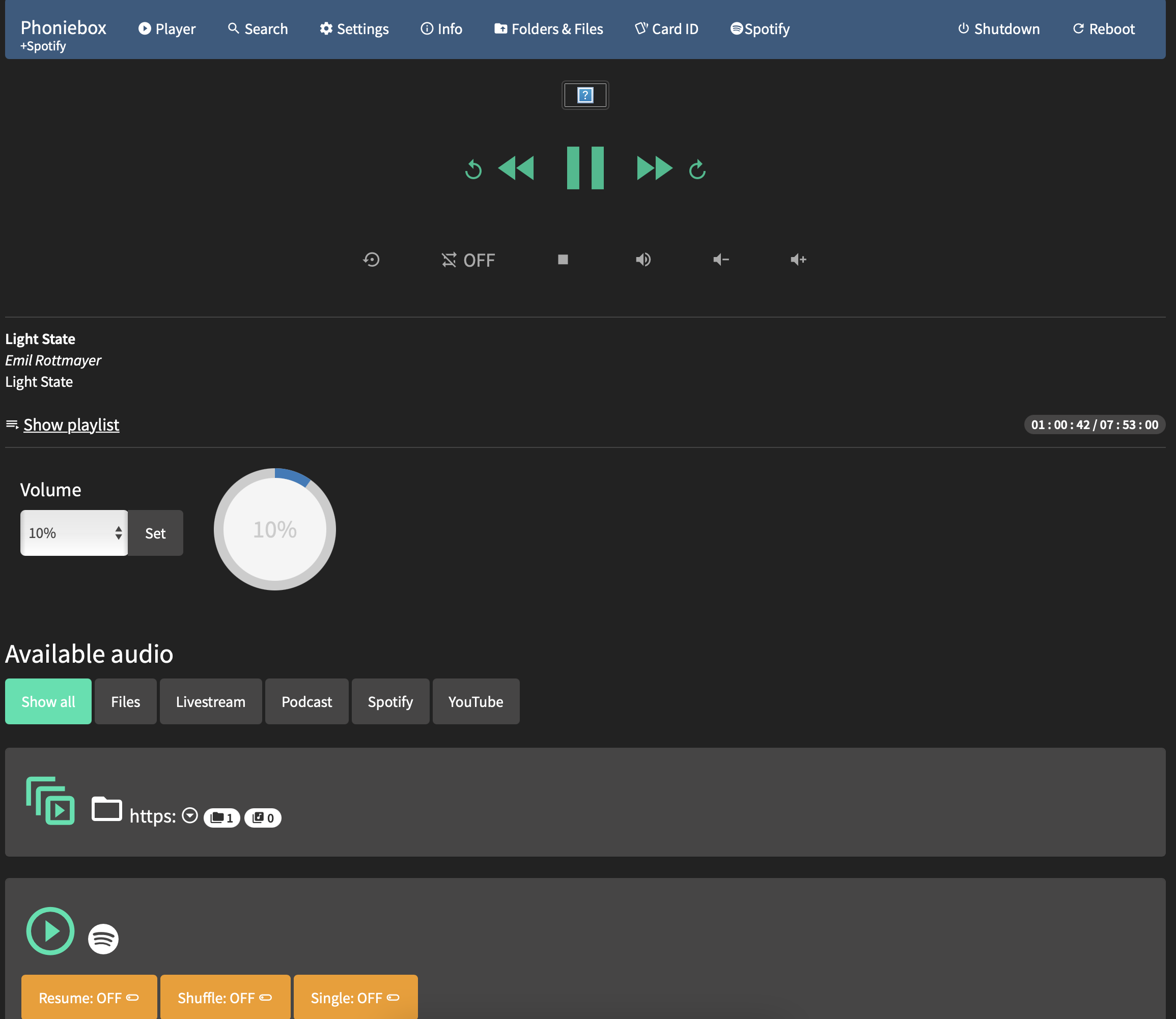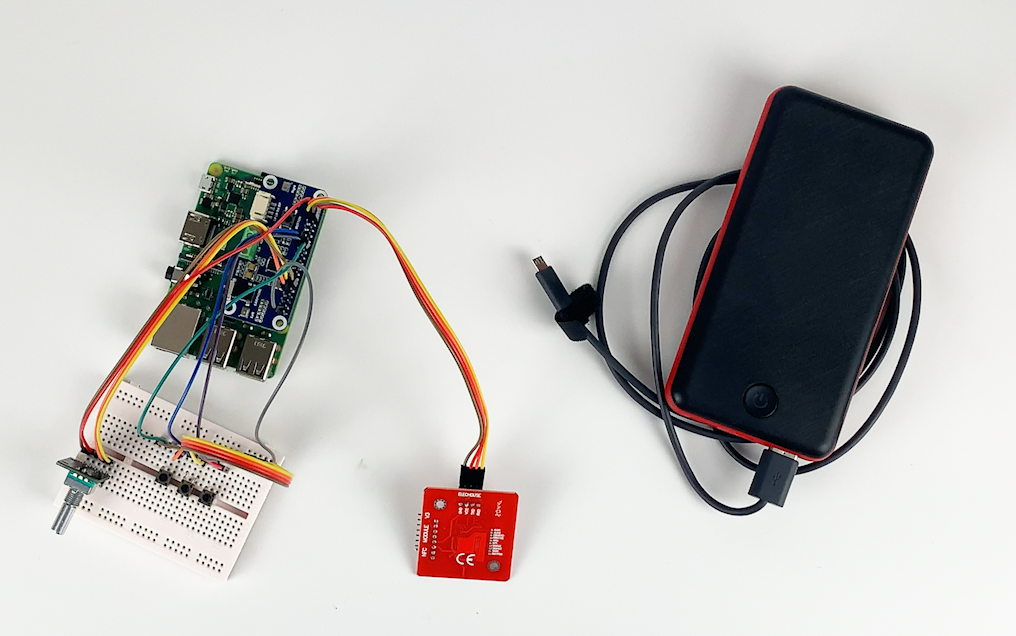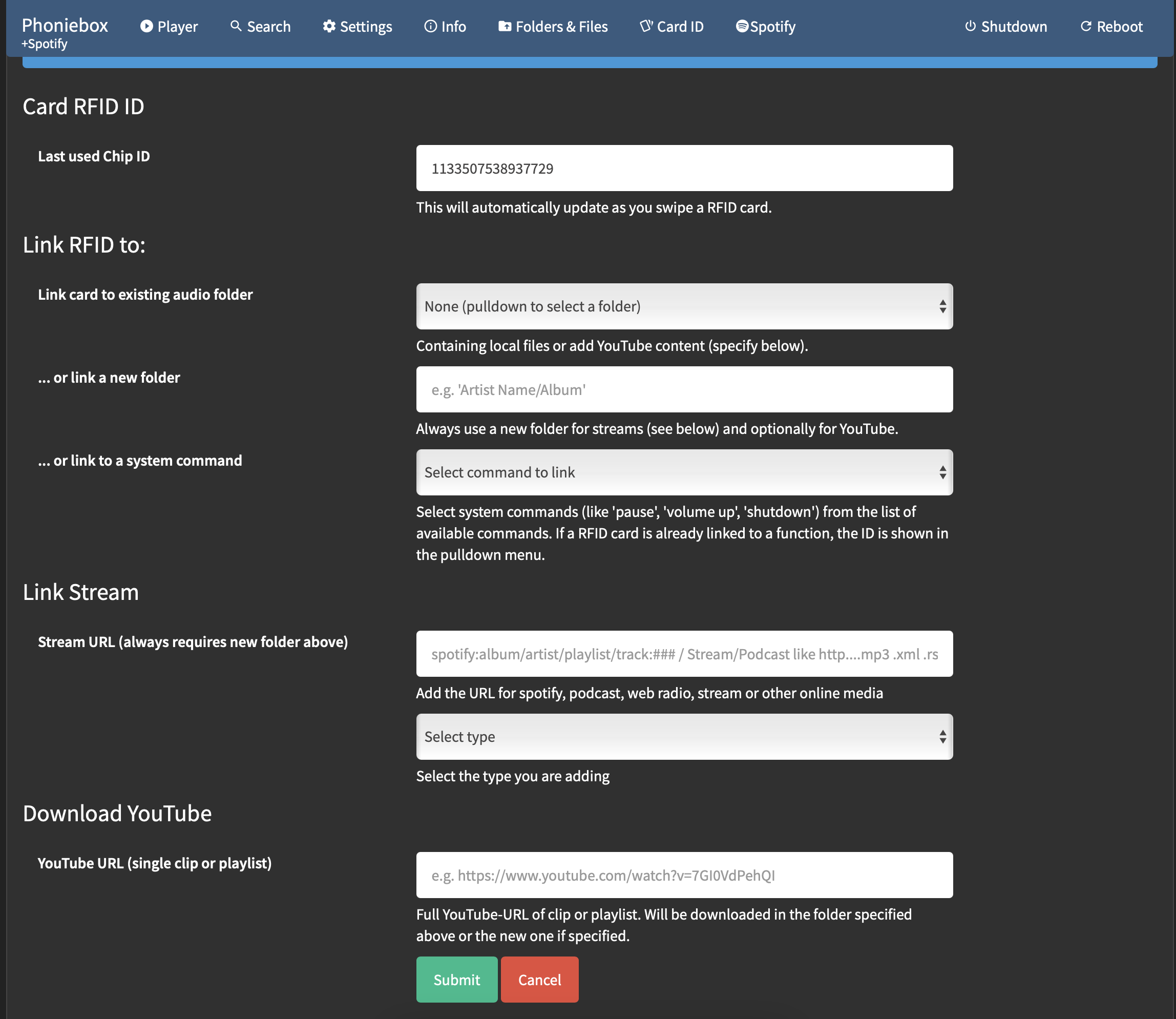The boombox is running Raspberry Pi Os Lite with Phoniebox which streams songs directly from Spotify using mopidy (you will need a Spotify Premium account) and provides a convenient web interface that can be accessed through the Pi's IP address. The web interface allows you to monitor and control playback, change settings and register new cards!
Tools I used are: Soldering Iron, Glue Gun, Wire Cutters, Screwdriver, Dremel/Angle Grinder

Hardware
Check out the video above to see how I put everything together! For a wiring guide see my github wiki.
- I used a Raspberry Pi 3B+ because I was originally planning on using Pimusicbox (which said it didn't support the Pi 4)
- I got a WM8960 Audio HAT which plugs into the Pi's GPIO Pins to be able to wire the speakers up and get better sound output. It communicates using I2C. Check the rating of your speakers and amplifier when connecting them to make sure they're suitable for each other. In this case, the original speakers are 6Ω 2W and the Amp can supply 1W per channel for 8Ω BTL. I choose this amp because it was easy to connect, didn't require an additional power supply and had GPIO pins that I could still use.
- The PN532 NFC/RFID reader also uses I2C to communicate with the Pi. It doesn't seem to clash with the WM8960 even though they share some pins.
- To control the music, I used the available contacts on the boombox for the Play/Pause Function. Keep in mind that your boombox might have a different mechanism or electronics, so you might have to adapt your design. I also wanted to implement Previous & Next song buttons, however, the buttons on the cassette player were mechanical buttons as they are meant to be used for fast forward and rewind. Because of this, they aren't actually wired to anything and normally stay "latched" when you press them down. To go around this, I removed the little metal tabs that latch them in place and added some push buttons internally right below them, so that when you press the original buttons it pushes on the push button internally. The location and way I placed them was not ideal, but I didn't have a 3D printer or additional materials to design a better solution. All buttons are connected directly to the GPIO pins and GND on the Pi, which were set to "pull up=True" to use the embedded pull up resistors.
- There is currently no On/Off button but this can be added. I currently turn it off using a web interface.
- The volume is controlled using a rotary encoder I glued in place to replace the previous potentiometer.
- Everything is powered using a 27000mAh power bank which can output 5V at 2.1A or 3A.
- I cut out the old battery compartment using a small angle grinder to add additional space for the Pi and Power bank inside the housing.

Software
On the software side of things, I found an amazing project by MiczFlor called Phoniebox. Big thanks to him and other contributors which made the software quite easy to set up. The Phoniebox project uses Mopidy in the backend to stream music from Spotify, Soundcloud or other services whenever it detects a new RFID/NFC tag. You will need a Spotify Premium account to stream from Spotify. It already has everything required to support RFID/NFC Tag reading, GPIO buttons and rotary encoders, so you just need to configure some files to make it work with your set up! I had to modify some of the source code to work with what I was trying to do (eg. play music while button is held down instead of clicked) so check out my changes in my forked repo.
I'm working on a step by step guide in my repo's wiki, but the overall steps are:
- Consider which mopidy services you want to use (I only tried Spotify as that is the only officially supported one by Phoniebox). Get your personal API keys from https://mopidy.com/ext/spotify/ which you will need to use in your config file.
- Install Raspberry OS Lite. Set up Wi-Fi and ssh.
- Install the Phoniebox repo (RPi-Jukebox-RFID) using the one line script. I made some changes for my project which you can find in my forked repo.
- Install additional things like NFC, Soundcard drivers etc
- Modify the config files to suit your setup (Eg. GPIO Buttons, Rotary Encoder, Audio Interface)
Setting up the RFID /NFC Tags
The web interface provides an easy way of setting up the RFID/NFC Tags using the Card ID Page. When you scan a new tag it will update the webform with the tag number. You can then link the tag to a Spotify playlist, youtube video etc. In the case of Spotify, you want to copy the Spotify URI to the Stream URL field.

Improvements
- The Pi and PowerBank are currently not secured with anything and could move around. There is a risk of shorting something or a component disconnecting so this should be solved asap.
- I didn't add a power button or switch to power on/off easily. I currently shutdown the Pi using the web interface. There is an option to add a button that can be configured in the software, so I might try to use the original power switch to turn it on/off.
- The volume control uses a rotary encoder because this was easier to connect to the Pi and configure, but as a result, it can spin around endlessly and doesn't really feel like a volume knob. To make it more realistic, this could be replaced by a potentiometer.
- Add an external USB connector to charge the power bank without removing it.
- I also don't know the remaining battery on the power bank so would be good to add some way of tracking this.
- I could maybe put the NFC reader towards one side of the cassette slot instead of the centre. That way I could add two NFC stickers to the cassettes (one left, one right) and I could mimic the A vs B side of the cassette with different playlists.
 Jorge Miar
Jorge Miar